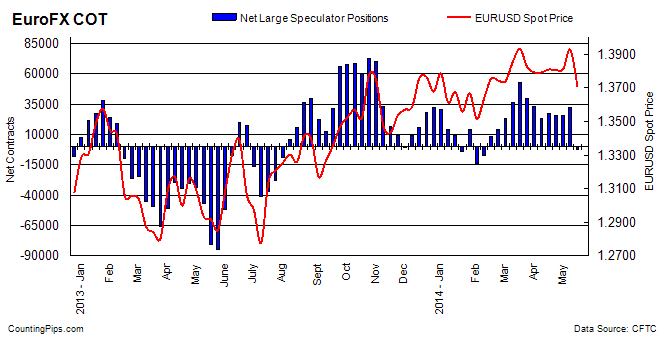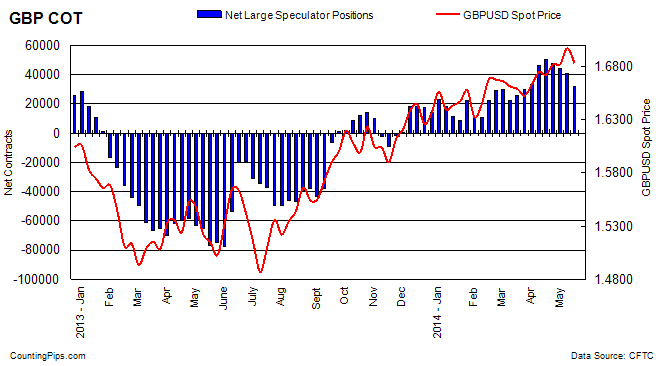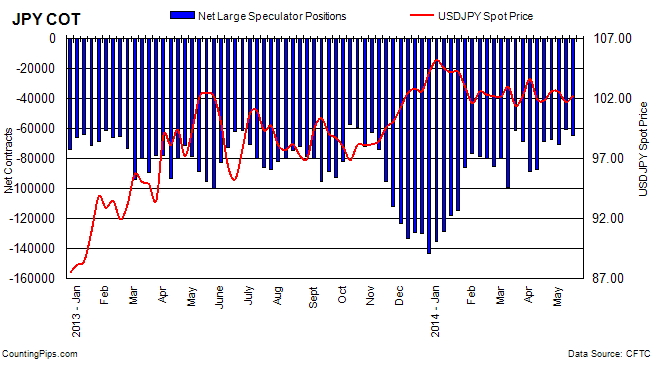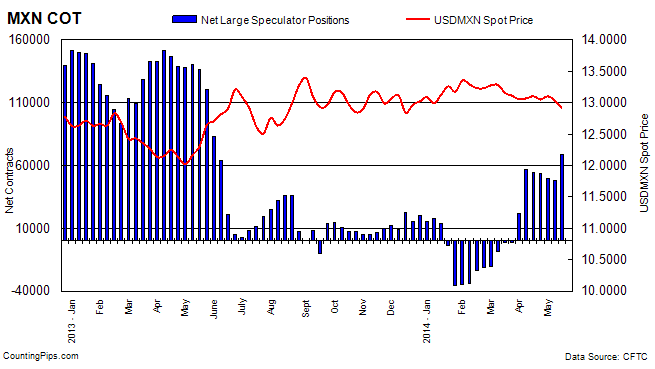By CountingPips.com
The latest data for the weekly Commitments of Traders (COT) report, released by the Commodity Futures Trading Commission (CFTC) on Friday, showed that large traders and speculators turned around their bets to become bullish on the US dollar last week. The previous four weeks had seen speculators and traders on the bearish side.
Non-commercial large futures traders, including hedge funds and large International Monetary Market speculators, had an overall US dollar long position totaling $4.51 billion as of Tuesday May 13th, according to the latest data from the CFTC and calculations by Reuters. This was a weekly change of +$6.54 billion from the -$2.03 billion total short position that was registered on May 6th, according to Reuters that totals the US dollar contracts against the combined contracts of the euro, British pound, Japanese yen, Australian dollar, Canadian dollar and the Swiss franc.
The US dollar aggregate bullish position is the highest USD level since March 11th when total bullish contracts equaled +$10.56 billion. The bullish gain of $6.54 billion was the largest weekly increase since November 12th 2013 when positions jumped by $7.44 billion for the week.
Overall for the week against the other major currencies, speculators bet in favor the Canadian dollar, Australian dollar and the Mexican peso last week while there were weekly declines for the euro, British pound sterling, Japanese yen, Swiss franc and the New Zealand dollar.
Notable changes:
- Euro positions fell sharply over to the bearish side for the first time since February 2nd as the European Central Bank suggested they were open to easing monetary policy in June
- British pound sterling positions fell for a 4th straight week after reaching a multi-year high on April 15th
- Japanese Yen net positions added bearish positions after touching the lowest bearish level since October 15, 2013 the previous week
- Swiss franc bullish positions declined by roughly half last week to +6,806 contracts
- Australian dollar net positions rose to their best level since April 30th 2013 after turning bullish on April 8th
- Canadian dollar positions, still bearish at -26,037 contracts, stood at the least bearish position since November 2013
* All currency positions are in direct relation to the US dollar where, for example, a bet for the euro is a bet that the euro will rise versus the dollar while a bet against the euro will be a bet that the dollar will gain versus the euro. Please see charts and data below.
Weekly Charts: Large Speculators Weekly Positions vs Currency Spot Price
EuroFX:
Last Six Weeks data for EuroFX futures
| Date | Open Interest | Long Specs | Short Specs | Large Specs Net | Weekly Change |
| 04/08/2014 | 261439 | 92635 | 69335 | 23300 | -9938 |
| 04/15/2014 | 270722 | 106252 | 78564 | 27688 | 4388 |
| 04/22/2014 | 266259 | 101204 | 75430 | 25774 | -1914 |
| 04/29/2014 | 271515 | 102285 | 76551 | 25734 | -40 |
| 05/06/2014 | 277013 | 110673 | 78122 | 32551 | 6817 |
| 05/13/2014 | 268142 | 84383 | 86558 | -2175 | -34726 |
British Pound Sterling:
Last Six Weeks data for Pound Sterling futures
| Date | Open Interest | Long Specs | Short Specs | Large Specs Net | Weekly Change |
| 04/08/2014 | 226667 | 91642 | 45165 | 46477 | 12905 |
| 04/15/2014 | 226688 | 87472 | 36874 | 50598 | 4121 |
| 04/22/2014 | 237055 | 89692 | 41892 | 47800 | -2798 |
| 04/29/2014 | 236030 | 85913 | 41679 | 44234 | -3566 |
| 05/06/2014 | 241264 | 83794 | 43148 | 40646 | -3588 |
| 05/13/2014 | 230333 | 71168 | 39413 | 31755 | -8891 |
Japanese Yen:
Last Six Weeks data for Yen Futures
| Date | Open Interest | Long Specs | Short Specs | Large Specs Net | Weekly Change |
| 04/08/2014 | 181814 | 13340 | 100802 | -87462 | 1176 |
| 04/15/2014 | 164843 | 14351 | 83067 | -68716 | 18746 |
| 04/22/2014 | 165674 | 16564 | 83807 | -67243 | 1473 |
| 04/29/2014 | 168820 | 13846 | 84198 | -70352 | -3109 |
| 05/06/2014 | 167093 | 20381 | 81109 | -60728 | 9624 |
| 05/13/2014 | 164707 | 17471 | 82178 | -64707 | -3979 |
Swiss Franc:
Last Six Weeks data for Franc futures
| Date | Open Interest | Long Specs | Short Specs | Large Specs Net | Weekly Change |
| 04/08/2014 | 44752 | 19275 | 7940 | 11335 | -2896 |
| 04/15/2014 | 48976 | 23905 | 9839 | 14066 | 2731 |
| 04/22/2014 | 46888 | 21732 | 7709 | 14023 | -43 |
| 04/29/2014 | 47424 | 21960 | 8257 | 13703 | -320 |
| 05/06/2014 | 55538 | 25102 | 11918 | 13184 | -519 |
| 05/13/2014 | 45282 | 16951 | 10145 | 6806 | -6378 |
Canadian Dollar:
Last Six Weeks data for Canadian dollar futures
| Date | Open Interest | Long Specs | Short Specs | Large Specs Net | Weekly Change |
| 04/08/2014 | 120336 | 28704 | 63011 | -34307 | 2687 |
| 04/15/2014 | 119525 | 28288 | 63714 | -35426 | -1119 |
| 04/22/2014 | 118707 | 27529 | 62984 | -35455 | -29 |
| 04/29/2014 | 123589 | 30093 | 60388 | -30295 | 5160 |
| 05/06/2014 | 122287 | 28044 | 59644 | -31600 | -1305 |
| 05/13/2014 | 121632 | 26986 | 53023 | -26037 | 5563 |
Australian Dollar:
Last Six Weeks data for Australian dollar futures
| Date | Open Interest | Long Specs | Short Specs | Large Specs Net | Weekly Change |
| 04/08/2014 | 96887 | 37630 | 34320 | 3310 | 8190 |
| 04/15/2014 | 98933 | 40463 | 32366 | 8097 | 4787 |
| 04/22/2014 | 107696 | 49540 | 33170 | 16370 | 8273 |
| 04/29/2014 | 109934 | 50019 | 39313 | 10706 | -5664 |
| 05/06/2014 | 104936 | 44805 | 36168 | 8637 | -2069 |
| 05/13/2014 | 107302 | 50147 | 33020 | 17127 | 8490 |
New Zealand Dollar:
Last Six Weeks data for New Zealand dollar futures
| Date | Open Interest | Long Specs | Short Specs | Large Specs Net | Weekly Change |
| 04/08/2014 | 32898 | 26521 | 6755 | 19766 | 1286 |
| 04/15/2014 | 33100 | 26671 | 6824 | 19847 | 81 |
| 04/22/2014 | 32579 | 26056 | 5881 | 20175 | 328 |
| 04/29/2014 | 29858 | 22979 | 4499 | 18480 | -1695 |
| 05/06/2014 | 33025 | 25027 | 4334 | 20693 | 2213 |
| 05/13/2014 | 30932 | 23806 | 4466 | 19340 | -1353 |
Mexican Peso:
Last Six Weeks data for Mexican Peso futures
| Date | Open Interest | Long Specs | Short Specs | Large Specs Net | Weekly Change |
| 04/08/2014 | 130331 | 70371 | 13870 | 56501 | 34717 |
| 04/15/2014 | 131412 | 71038 | 16801 | 54237 | -2264 |
| 04/22/2014 | 128932 | 68329 | 14818 | 53511 | -726 |
| 04/29/2014 | 128100 | 68073 | 18455 | 49618 | -3893 |
| 05/06/2014 | 146455 | 67663 | 19779 | 47884 | -1734 |
| 05/13/2014 | 149209 | 86137 | 17515 | 68622 | 20738 |
*COT Report: The weekly commitment of traders report summarizes the total trader positions for open contracts in the futures trading markets. The CFTC categorizes trader positions according to commercial hedgers (traders who use futures contracts for hedging as part of the business), non-commercials (large traders who speculate to realize trading profits) and nonreportable traders (usually small traders/speculators).
The Commitment of Traders report is published every Friday by the Commodity Futures Trading Commission (CFTC) and shows futures positions data that was reported as of the previous Tuesday (3 days behind).
Each currency contract is a quote for that currency directly against the U.S. dollar, a net short amount of contracts means that more speculators are betting that currency to fall against the dollar and a net long position expect that currency to rise versus the dollar.
(The graphs overlay the forex spot closing price of each Tuesday when COT trader positions are reported for each corresponding spot currency pair.)
See more information and explanation on the weekly COT report from the CFTC website.
Article by CountingPips.com – Forex Apps & News















